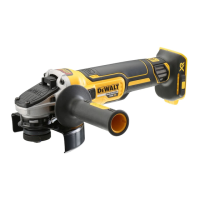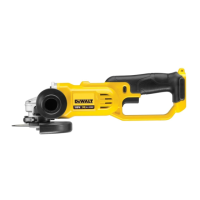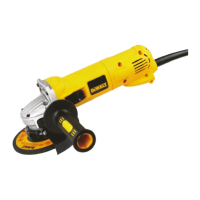13
ENGLISH
1. Loosen screw, until the guard lug
19
can rotate freely in the
groove
20
on the gear case hub.
2. Rotate guard
8
into desired working position. The guard
body should be positioned between the spindle and the
operator toprovide maximum operator protection.
3. Tighten the screw to secure the guard on the gear case
cover. (Fasten torque no less than 2.5 N-M). You should be
unable to rotate the guard by hand. Do not operate grinder
with a loose guard.
4. To remove the guard, loosen screw and pull up on the
guard.
CAUTION: Failure to properly seat the wheel before
turning the tool on may result in damage to the tool or
the wheel.
Flanges and Wheels
Mounting Non-Hubbed Wheels (Fig. E)
WARNING: Failure to properly seat the flanges and/or
wheel could result in serious injury (or damage to the tool
or wheel).
CAUTION: Included flanges must be used with depressed
centre Type 27 and Type 42 grinding wheels and
Type41 cutting wheels. See the Accessories Chart for
moreinformation.
WARNING: A closed, two-sided cutting wheel guard is
re quired when using cuttingwheels.
WARNING: Use of a damaged flange or guard or fail ure
to use proper flange and guard can re sult in injury due to
wheel breakage and wheel contact. See the Accessories
Chart for moreinformation.
1. Place the tool on a table, guardup.
2. Install the backing flange
6
on spindle
4
with the raised
centre (pilot) facing the wheel. Press the backing flange
intoplace.
3. Place wheel
19
against the backing flange, centreing the
wheel on the raised centre (pilot) of the backingflange.
4. While depressing the spindle lock button and with the hex
depressions facing away from the wheel, thread the locking
flange
7
on spindle so that the lugs engage the two slots
in thespindle.
5. While depressing the spindle lock button, tighten the
locking flange
7
by hand or using the wrench supplied.
(Only use a locking flange if it is in perfect condition.) Refer
to Accessory Chart to see flangedetails.
6. To remove the wheel, reverse the aboveprocedure.
Mounting Sanding Backing Pads (Fig. F)
NOTE: Use of a guard with sanding discs that use backing pads,
often called fiber resin discs, is not required. Since a guard is
not required for these accessories, the guard may or may not fit
correctly ifused.
WARNING: Failure to properly seat the flange/ clamp nut/
wheel could result in serious injury (or damage to the tool
or wheel).
WARNING: Proper guard must be reinstalled for grinding
wheel, cutting wheel, sanding flap disc, wire brush or
wire wheel applications after sanding applications
arecomplete.
1. Place or appropriately thread backing pad
16
on
thespindle.
2. Place the sanding disc
17
on the backing pad
16
.
3. While depressing spindle lock
3
, thread the clamp nut
18
on the spindle, piloting the raised hub on the clamp nut into
the centre of san ding disc and backingpad.
4. Tighten the clamp nut by hand. Then depress the spindle
lock button while turning the sanding disc until the sanding
disc and clamp nut aresnug.
5. To remove the wheel, grasp and turn the backing pad and
sanding pad while depressing the spindle lockbutton.
Mounting and Removing Hubbed Wheels
(Fig. A)
Hubbed wheels install directly on the threaded spindle. Thread
of accessory must match thread ofspindle.
1. Remove backing flange by pulling away fromtool.
2. Thread the wheel on the spindle
4
byhand.
3. Depress the spindle lock button
3
and use a wrench to
tighten the hub of thewheel.
4. To remove the wheel, reverse the aboveprocedure.
NOTICE: Failure to properly seat the wheel before turning
the tool on may result in damage to the tool or thewheel.
Mounting Wire Cup Brushes and
Wire Wheels (Fig. A)
WARNING: Failure to properly seat the flange/ clamp nut/
wheel could result in serious injury (or damage to the tool
or wheel).
CAUTION: To reduce the risk of personal injury,
wear work gloves when handling wire brushes and
wheels. They can becomesharp.
CAUTION: To reduce the risk of damage to the tool,
wheel or brush must not touch guard when mounted
or while in use. Undetectable damage could occur to
the accessory, causing wires to fragment from accessory
wheel orcup.
Wire cup brushes or wire wheels install directly on the threaded
spindle without the use of flanges. Use only wire brushes or
wheels provided with a threaded hub. These accessories are
available at extra cost from your local dealer or authorised
servicecentre.
1. Place the tool on a table, guardup.
2. Thread the wheel on the spindle byhand.
3. Depress spindle lock button
3
and use a wrench on the
hub of the wire wheel or brush to tighten thewheel.
4. To remove the wheel, reverse the aboveprocedure.
NOTICE: To reduce the risk of damage to the tool, properly
seat the wheel hub before turning the toolon.

